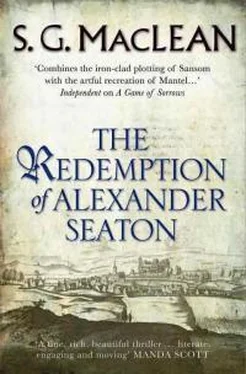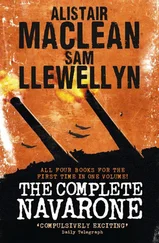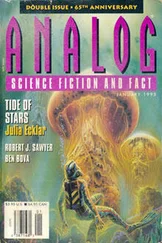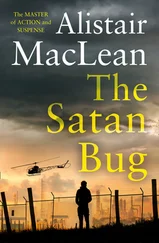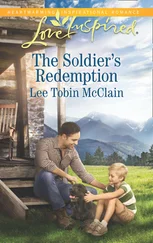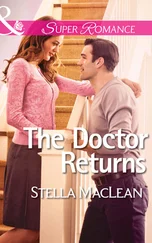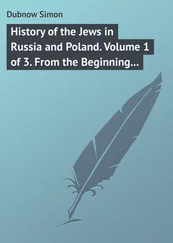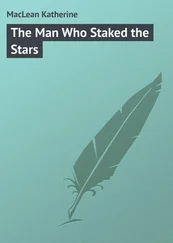‘It rages.’
‘And what do you recall of events after you left the lykewake?’
I closed my eyes and searched my memory for something. Fleeting glimpses of things came to me, a sensation of apprehension, but little else. I tried again. This time there was something more, and apprehension was replaced by real fear. I looked to the doctor and swallowed hard. ‘I think, it is hazy, you know, but I think at the kirkyard,’ I hesitated, not knowing how the baillie would react to what I had to say.
‘Go on,’ said Jaffray.
I glanced at the baillie for a moment. ‘I think I saw the dead walk.’ I had expected thunderous rebuke, accusations of blasphemy, witchcraft, consorting with spirits, but none came. William Buchan merely looked at the doctor and the doctor nodded.
‘The visions. You saw the visions. The belladonna brings on hallucinations. It is what the witches use to send them on their orgies of commune with the dead, to send them in their flights for Satan. It is fortunate for your mind and soul that the baillie came upon you when he did.’
‘And for my body too,’ I added. ‘I do not think the provost had it in mind that I should live to tell his tale.’
‘No,’ agreed Jaffray. ‘No more do I.’ He went and murmured something to the notary who, nodding, sent one of the doorkeepers back down the stairs. The baillie had joined the doctor and the notary in conference, and for a moment none heeded me. I strained to hear their words, but could make out little. William Buchan asked Jaffray for news of the provost, but all I could hear by way of reply was ‘Carnousie’. Carnousie. Nearer Turriff than Banff, yet away from the sea. If he wanted to get away, he should have gone by the sea. Some more instructions were relayed further down the castle and attention returned to me.
‘Mr Seaton,’ said the baillie, ‘I doubt the doctor will permit you to be moved again for some days–’
‘Indeed I will not,’ interrupted Jaffray with some emphasis.
‘And the notary and myself cannot tarry much longer from Banff. There is much to be attended to. Nevertheless, there is much I would know of you.’
‘And perhaps tell me?’
He eyed me steadily for a moment. His mouth scarcely moved. ‘Perhaps. But first, I would be grateful if you would tell me what you were telling the notary when I entered the room.’
My head was thumping more than ever, and again I tried to remember. I looked to Thomas Stewart for help and he lifted paper from a shelf by the door and began to read. In my first moments of bleary consciousness, I had not noticed him writing it. ‘When I asked you how you had known, you said that Patrick Davidson had told you.’
I remembered. A dead man had spoken to me, and I had listened, and heard, and understood at last, as I had not done while he lived. And so I told them, and as I spoke, the notary wrote. I told them, with shame, but honestly, of my staggering vision on the night of the murder, of the whores and of the man in the gutter. I told them of seeing Janet Dawson beaten from the burgh to the rhythm of the drum, and of her desperate words to me before she was torn away, Patrick Davidson’s last words. Not ‘James and the flowers’ as she and her sister believed they had heard on that stormy, drink-fuelled night, from the lips of a vomiting, dying man, but ‘Jamesone – the flowers’. George Jamesone and the flowers – the colchicum mortis – falling from the open hand of Patrick Davidson’s aunt, dead eight years. As I had finally realised last night at the lykewake, the painter’s words had come back to me, ‘You look, but you do not see.’ Standing in the great hall of the provost’s house, with the body of Patrick Davidson lying on a table beside me, I had seen a portrait hanging on the wall. It was a portrait of a man and a woman, a wellmade man and his pale, grieving wife, flowers falling from her hand and lying crushed and lifeless at her feet. Their lost children, each a perfect promise of beauty in this life, of hope, that had slipped from her grasp. And around them, amongst the paraphernalia of their wealth, their attainments and their aspirations, hidden away in a dark corner, almost out of sight, was a lute, a lute with a broken string. Disharmony, a love that has been strained and snapped, the painter’s vision of what he truly saw before him. Completed only a few weeks before Helen Black, the aunt of Patrick Davidson and first wife of Walter Watt, Provost of Banff, had died. The loved, beloved aunt; the aunt who had been almost a mother to him.
The grieving boy had left and studied and prospered in the world. And in that world he had pursued the love of botany, planted in him by the conversations at his uncle’s fireside between Walter Watt and James Cargill, physician and great botanist. Had the provost not told us so himself? The boy had travelled, and the career in law, so dry, so lacking in the life and sun and water and air and colour and texture and fragrance that he truly loved, had gradually been pushed aside as he became more and more entranced by the world of science, of medicine and, above all, of plants. Patrick Davidson had known his calling: he would study the apothecary’s art. And where else would he go to apprentice than the place of his happy boyhood, where the first stirring of that love for the minute perfections of God’s creation had taken him? And so he had returned to Banff, and had been welcomed by the provost as a lost son, and taken to the heart of a new family. He had sat down to dine in his uncle’s great hall, and let his eyes drift up to rest for a moment on the face of his dearly loved, long-dead aunt. But just for a moment, for then his eyes travelled further, to her hand and past her skirts to the floor, and he saw what he should not have been able to see. He saw what had no godly cause to be in that painting, or in this town, or this land even. He saw the flowers whose only use, beautiful though they were, was the procuring of a death, her death. But he did not let himself make the connection, did not want to see it, until he went with Marion Arbuthnott to Darkwater.
‘And what did he learn there? What did you learn there?’ asked the baillie in a strange voice. He knew the answer but did not wish to know it.
There was no need for me to tell them of the child that Marion had been carrying – if they did not know it already, it was none of their concern. A vision of my own mother came to me, but I pushed it away. ‘He learned,’ I began, ‘that his aunt, Helen, had gone to her in desperation, after all that Jaffray,’ I looked at the doctor and with an incline of his head he urged me to go on, ‘after all that Jaffray or any other could do to help her carry a living child to its delivery failed her.’
‘There were many others who did the same,’ said the doctor, softly. ‘Would to God that he had given me the skill to effect that if nothing else.’
The expected reproof from the baillie did not come. He simply said, ‘Continue, Mr Seaton.’ We had yet to come to the point.
‘They learned that eight years ago, Helen Black, from grief and fear, had almost reached the limits of her senses.’
The notary laid off his writing. ‘Do you say she took her own life?’
I opened my mouth to answer, but the baillie was there before me, speaking quietly, as to himself. ‘No, never that. It was taken from her.’
Thomas Stewart looked from one to the other of us. ‘The crone told you this?’
I started to shake my head but the pain stilled me. ‘No, she did not. But I think, I am almost certain, that the knowledge of his aunt’s fear and desperation, so close to the time of her death – the same time at which the picture, with those flowers in it, was painted – convinced Patrick Davidson that his aunt had been poisoned.’
Читать дальше
